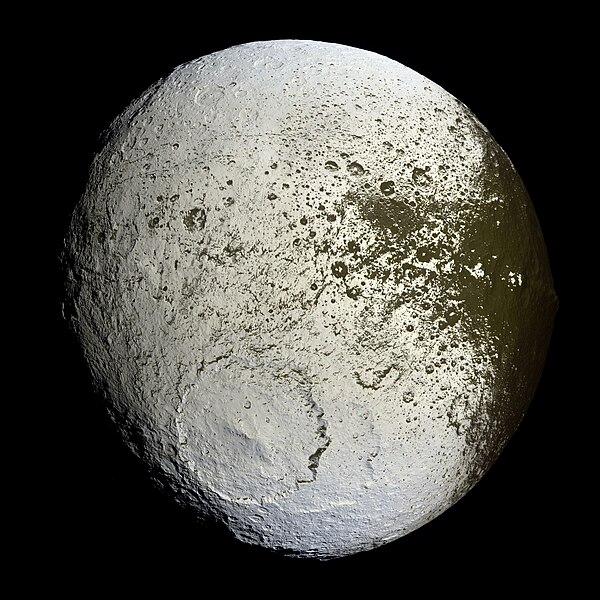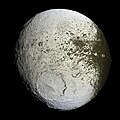Talaksan:Iapetus as seen by the Cassini probe - 20071008.jpg

Laki ng pasilip na ito: 600 x 600 na pixel. Ibang mga resolusyon: 240 x 240 na pixel | 480 x 480 na pixel | 768 x 768 na pixel | 1,024 x 1,024 na pixel | 2,048 x 2,048 na pixel | 4,032 x 4,032 na pixel.
Buong resolusyon ((4,032 × 4,032 pixel, laki ng talaksan: 6.22 MB, uri ng MIME: image/jpeg))
Nakaraan ng file
Pindutin ang araw/oras upang makita kung papaano ang itsura ng talaksan noong oras na iyon.
| Araw/Oras | Thumbnail | Mga dimensiyon | tagagamit | Kumento | |
|---|---|---|---|---|---|
| ngayon | 18:07, 12 Disyembre 2018 |  | 4,032 × 4,032 (6.22 MB) | Kesäperuna | 100% JPEG quality from full quality TIFF, slightly cropped to be more centered. |
| 09:18, 9 Oktubre 2007 |  | 4,100 × 4,100 (1.56 MB) | Startaq | {{Information |Description = Cassini captures the first high-resolution glimpse of the bright trailing hemisphere of Saturn's moon Iapetus. This false-color mosaic shows the entire hemisphere of Iapetus (1,468 kilometers, or 912 miles across) visible fro |
Mga ugnay
Nakaturo sa talaksan na ito ang mga sumusunod na mga pahina:
Pandaigdigang paggamit sa file
Ginagamit ng mga sumusunod na wiki ang file na ito:
- Paggamit sa af.wikipedia.org
- Paggamit sa an.wikipedia.org
- Paggamit sa ar.wikipedia.org
- Paggamit sa ary.wikipedia.org
- Paggamit sa arz.wikipedia.org
- Paggamit sa ast.wikipedia.org
- Paggamit sa az.wikipedia.org
- Paggamit sa ba.wikipedia.org
- Paggamit sa be.wikipedia.org
- Paggamit sa bg.wikipedia.org
- Paggamit sa bn.wikipedia.org
- Paggamit sa bn.wikibooks.org
- Paggamit sa bs.wikipedia.org
- Paggamit sa ca.wikipedia.org
- Paggamit sa ckb.wikipedia.org
- Paggamit sa cs.wikipedia.org
- Paggamit sa cv.wikipedia.org
- Paggamit sa cy.wikipedia.org
- Paggamit sa de.wikipedia.org
Tingnan ang karagdagang pandaigdigang paggamit sa file na ito.




